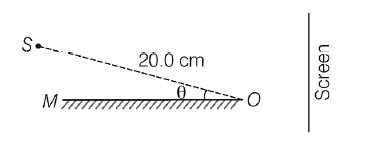Q.
A monochromatic light source $S$ of wavelength $440\, nm$ is placed slightly above a plane mirror $M$ as shown below. Image of $S$ in $M$ can be used as a virtual source to produce interference fringes on the screen. The distance of source $S$ from $O$ is $20.0\, cm$ and the distance of screen from $O$ is $100.0\, cm$ (figure is not to scale). If the angle $0 = 0.50$ x $10^{-3}$ radians , then the width of the interference fringes observed on the screen is

KVPYKVPY 2016Wave Optics
Solution:
